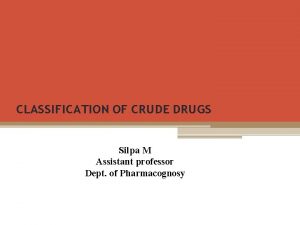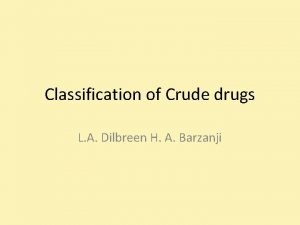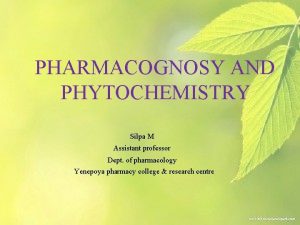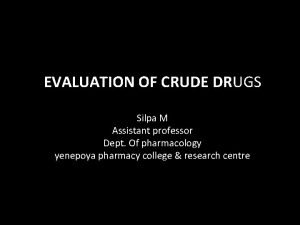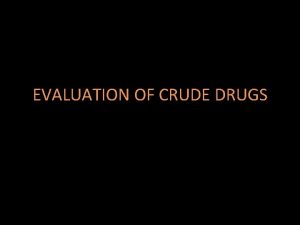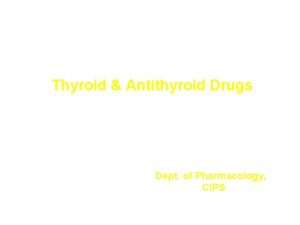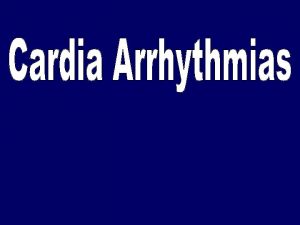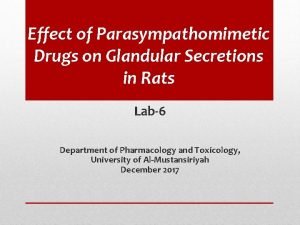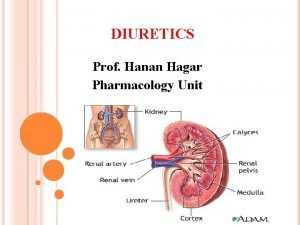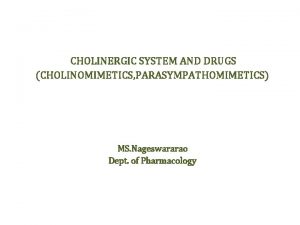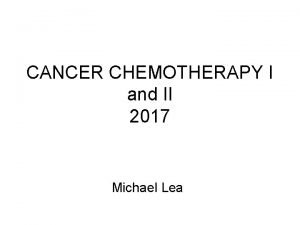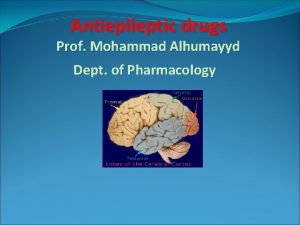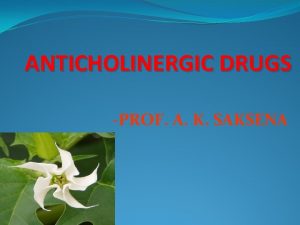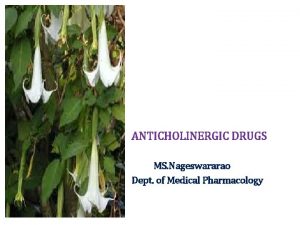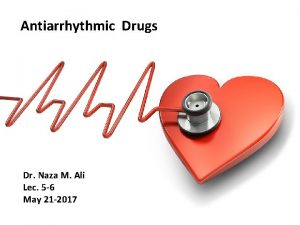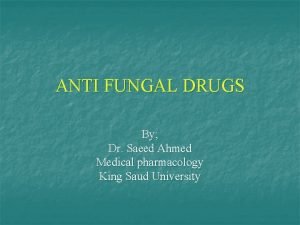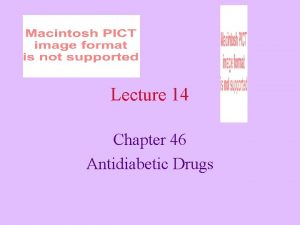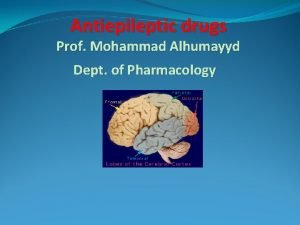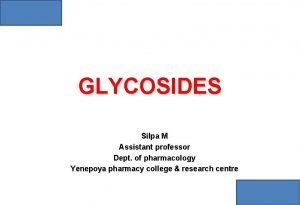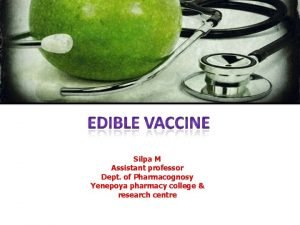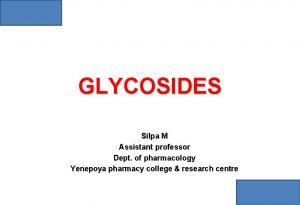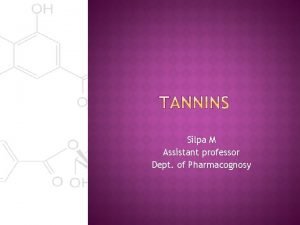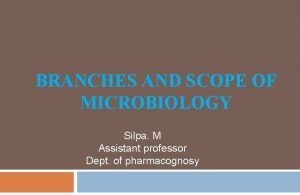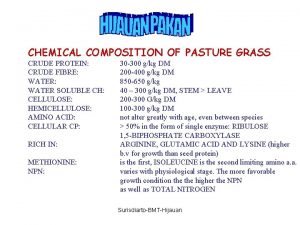CLASSIFICATION OF CRUDE DRUGS Silpa M Assistant professor
































- Slides: 32

CLASSIFICATION OF CRUDE DRUGS Silpa M Assistant professor Dept. of Pharmacognosy

Classification of crude drugs • Crude drug i. e Simple drug • Crude drugs are plant, animal or their parts which after collection are subjected only to drying or making them into transverse/ longitudinal slices pieces or peeling them in some cases. They exist in natural form. • Crude drugs may be derived from various natural sources like plants, animals, minerals and microorganisms etc.

• Because of their wide distribution the arrangement of classification in a definite sequence is necessary to understand easily. Although each system of classification has its own merits and demerits, but for the purpose of study the drugs are classified in the following different ways: Alphabetical classification Morphological classification Taxonomical classification Pharmacological classification Chemo-taxonomical classification

1. Alphabetical classification • The crude drugs are arranged according to the alphabetical order/form of their Latin and English names. Some of the Pharmacopoeias and reference books which classify crude drugs according to this system are as follows.

1) Indian Pharmacopoeia (IP) 1955 (Latin) 2) Indian Pharmacopoeia (IP) 1966 (English) 3) British Pharmacopoeia (BP) (English) 4) British Pharmacopoeia Codex (BPC) (English) 5) United States of Pharmacopoeia (USP) (English) 6) European Pharmacopoeia (Latin)

Advantages: • It is simple method, in this system location, tracing and addition of the drug is easy, • No technical person is required for handling the system. Disadvantages: • Scientific nature of the drug cannot be identified by this method, whether they are organised or unorganised drug. • This system does not help in distinguishing the drugs of plant, animal and mineral source. (Original source is not clear)

Examples: • , Acacia, Agar, Benzoin, Beeswax, Cinchona, Cinnamon, Digitalis, Datura, Ephedra, Fennel, Ginger, Isapagol, Jalap, Kino, Linseed, Mustard, Nutmeg, etc.

2. Morphological classification • According to the drugs part are arranged (Grouped) of the plant or animal represented into organised (cellular) drugs and unorganised (Acellular) drugs. • Organised (Cellular): • Drugs are the direct parts of the plant and are divided into leaves, barks wood, root, rhizome, seed, fruit, flower, stem, hair and fibers. :

• Unorganised ( Acellular): • Drugs are the products of plant, animal and mineral source and they are divided into dried latex, dried juice, dried extracts, gums, resins, fixed oils and fats, waxes, volatile oil, animal products, minerals (Solids, liquids, semi solids etc).

Plant parts Organised drugs (Plant) (Cellular drugs) Drugs Leaves Datura, Senna, Vasaka, Digitalis, Barks Cinnamon, Cinchona, Kurchi, Wood Quassia, Sandalwood, Red sanders Roots Rauwolfia, Liquorice, Ipecac Rhizomes Ginger, Podophyllum, Turmeric Flowers Clove, Saffron, Pyrethrum Seeds Nux vomica, Linseed, Isapgol Fruits Fennel, Coriander, Dill Stems Ephedra Hair and Fibres Cotton, Hemp, Jute

Organised drugs (Plant) (Cellular drugs) Plant, animal, Mineral Drugs Dried latex Opium, Papain Dried Juice Aloe, Kino Dried extracts Gums Acacia, Tragacanth, Stericulia Resins Benzoin, Colophony, Asafoetida Fixed oils and fats Castor , Chaulmoogra, Cotton seed Waxes Beeswax, Spermaceti Volatile oils Coriander, Cinnamon, Clove Animal products Bees wax, Shark liver oil, Gelatin Minerals Bentonite, Kaolin, Talc

• Advantages: • This system of classification is more convenient for practical study especially when the chemical nature of the drug is not clearly understood. • This type of classification is very useful in identifying the adulterants : used. • Disadvantages • it is does not give an idea about biological source chemical constituents and uses. • It is difficult to classify unorganized drugs. • Processing of drugs like collection, drying and preparation for market may change their original characters making recognition quite difficult.

3. Chemical classifications of crude drugs • Here, the crude drugs are divided into different groups according to the chemical nature of their most important constituent present in the drug to which the pharmacological/therapeutic activity of drug is attributed.

Chemical constituents Drugs Alkaloids Datura, Vasaka, Vinca, Lobelia Glycosides Cascara, Senna, Digitalis Tannins Catechu, Myrobalan, Ashoka Volatile oil Clove, Eucalyptus, Cinnamon Lipids Castor oil, Beeswax, Arachis oil Carbohydrates and derived products Acacia, Agar, Honey, Linseed Tragacanth, Starch Resins Colophony, Benjoin, Vitamins & hormones Yeast, Shark liver oil, Insulin Proteins & enzymes Gelatin, Papain,

Advantages : • Chemical constituents are known, • Medicinal uses are known Disadvantages : • Drugs of different origin are grouped under similar chemical titles. • This type of classification makes no proper placement of drugs containing two different types of chemicals. • Eg: Certain drugs are found to contain alkaloids and glycosides (Cinchona), Fixed oil and volatile oil (Nutmeg) of equal importance together and hence it is difficult to categorize them properly

4. T axonomical classification of cr ude drugs • In this system the drug are arranged according to taxonomical studies. The drugs are arranged according to their phylum, order, family, genus and species. It is purely a type of botanical classification or biological classification and restricted mainly to crude drugs from plant source.

Phylum Order Family Drugs Angiosperms (Monocotyledons) Liliflorae Liliaccae Colchicum, Asparagus Microspermae Dioscoriaceae Papaverales Papaveraceae Opium Rosales Almond, Rose oil Leguminaceae Glycyrihiza, Senna Rutales Rutaceae Bael, Lemon, Orange Rhamnales Rhamnaceae Cascara Malvales Malvaceae Cotton Umbelliflorae Umbelliferae Coriander, Caraway, Fennel Gentianales Loganiaceae Nuxvomica Gentianceae Chirata Apocyanaceae Kurchi, Strophanthus Angiosperms (Dicotyledons)

• Advantages: • Easy for the classification of crude drugs • Disadvantages: • The system is criticized for its failure to recognize the organised / unorganised nature of crude drugs in their morphological studies. • The system fails to face into an account chemical nature of active constituent and therapeutic significance of crude drugs. • The drugs obtained from plants having alternate leaves, flowers, seeds, capsules (Hyocyamus, Datura, Bellodonna, Stromonium) are considered with other members of solanaceae.

5. P har m acological classification of cr ude drugs: Here, the crude drugs are grouped according to pharmacological action (Therapeutic action) of their chief active constituent (most important) or therapeutic uses. • It is also known as Therapeutic classification.

Bitter Quassia, Cinchona, Gentian Carminatives Dill, Clove, Fennel, Coriander Emetics Ipecac Anti-amoebic Kurchi, Ipecac Bulk Laxatives Agar, Isapgol Purgatives Senna, Castor oil Expectorant Liquorice, Vasaka, Ipecac Antitussive Opium Bronchodilators Ephedra, Tea Cardio- tonics Digitalis, Squill, Stropanthus

Cardiac depressant Cinchona, Veratrum Antihypertensive Rauwolfia Central analgesics Opium CNS stimulants Coffee CNS depressants Opium Antispasmodics Bellodonna Anticancer Vinca, Podophyllum, Cochicum Antirheumatics Aconite, Guggul, Colchicum Anthelmintic Vidang, Quassia, Malefern Astringents Catechu. Antimalarials Cinchona, Artemisia Local anesthetics Coca

• Advantages • The special advantage is that if even chemical constituents of the crude drugs are not known they can be classified properly on the basis of therapeutic or pharmacological uses. • Disadvantages • Regardless of morphology, taxonomical status or chemical nature, the drugs are grouped together, provided they exhibit similar pharmacological uses. • Eg: Senna, Castor oil, Jalap, Colocynth are grouped together as purgatives/laxatives because of their common pharmacological action.

6. Chemo- taxonomical classification of crude drugs • In this system of classification, the equal importance is given for taxonomical status and chemical constituents. • There are certain types of chemical constituents which are characteristics of certain classes of plants. • Eg: Tropane alkaloids generally occur in most of the members of Solanaceae • Volatile oils occur in the members of Umbelliferae and Rutaceae.

7. SEROTAXONOMICAL CLASSIFICATION • The serotaxonomy can be explained as the study about the application or the utility of serology in solving the taxonomical problems. • Serology can be defined as the study of the antigen–antibody reaction. • Antigens are those substances which can stimulate the formation of the antibody. • Antibodies are highly specific protein molecule produced by plasma cells in the immune system.

• Protein are carriers of the taxonomical information and commonly used as antigen in serotaxonomy. • It expresses the similarities and the dissimilarities among different taxa, and these data are helpful in taxonomy. • It determines the degree of similarity between species, genera, family, etc. , by comparing the reaction with antigens from various plant taxa with antibodies present against a given taxon.

• Serology helps in comparing non morphological characteristics, which helps in the taxonomical data. • This technique also helps in the comparison of single proteins from different plant taxa.

Question bank Long Essays: 10 Marks. 1. Define crude drug. Discuss various methods of classification of crude drugs with examples. 2. Discuss the various methods of classification of crude drugs with particular emphasis on the merits of each method. 3. Explain in detail chemical and pharmacological methods of classification of crude drugs with examples. 4. Describe different methods of classification of crude drugs with examples. Give its advantages and disadvantages. 5. Define crude drug. Enlist different method of classifying crude drugs. 6. Explain in detail pharmacological method of classification.

7. Describe the classification of crude drugs based on chemical constituents and pharmacological activity with examples. 8. What is chemotaxonomy? Add a note on significances of chemotaxonomy. 9. Write a note on advantages/merits and disadvantages/demerits of various methods of classification of crude drugs. 10. Explain in detail botanical/ taxonomical and morphological classification of crude drugs with examples. 11. Explain in detail alphabetical and pharmacological classification of crude drugs with examples. 12. Explain the taxonomical and chemo-taxonomical classification of crude drugs with examples. • Explain in detail morphological and pharmacological classification of crude drugs with examples. • Explain in detail morphological and chemical classification of crude drugs with examples.

Short Essays: 5 Marks 1. Write a note on morphological classification of crude drugs with examples. 2. Write a note on differences between organized and unorganized drugs with examples. 3. Enumerate with examples chemical classification of crude drugs. 4. Explain with examples therapeutic classification of crude drugs. 5. Give the chemical classification of crude drugs with examples. 6. Explain the taxonomical and chemo- taxonomical classification of crude drugs with examples. 7. Give the pharmacological classification of crude drugs with examples

Short Answers: 2 Marks 1. Define chemotaxonomy. Give examples. 2. Give the significances of chemotaxonomy. 3. Classify the crude drugs based on alphabetical method of classification. 4. What are organized and unorganized drugs give examples. 5. Give the advantages and dis advantages of chemical classification. 6. Give the advantages and dis advantages of pharmacological classification. 7. Give the advantages and dis advantages of morphological classification. 8. Give the advantages and dis advantages of alphabetical classification. 9. Give the advantages and dis advantages of taxonomical classification. 10. Give the advantages and dis advantages of chemotaxonomical classification.

Question bank • 1. Define crude drug 2 marks • 2. Name the various methods of classification of crude drugs. 2 marks • 3. What do you mean by organised ( Cellular) and unorganised ( Acellular ) crude drugs give examples 5 marks • 4. Describe morphological classification of crude drugs with examples 5 marks • 5. Explain chemical classification of crude drugs with examples 5 marks • 6. Explain chemical classification of crude drugs with

• 7. Explain pharmacological or therapeutic classification of crude drugs with examples 5 marks • 8. Write in detail alphabetical and taxonomical or botanical classification of crude drugs 5 marks • 9. Define chemotaxonomy. Give examples. 2 marks • 10. Explain the differences between organised and unorganised crude drugs. 5 marks • 11. Define crude drug. Explain various methods of classification of crude drugs with examples 10 marks
 Dried juice in pharmacognosy
Dried juice in pharmacognosy Classification of crude drugs
Classification of crude drugs Classification of crude drugs
Classification of crude drugs Parent portal amnuay silpa
Parent portal amnuay silpa Amnuay silpa tuition fee
Amnuay silpa tuition fee Organised and unorganised drug difference
Organised and unorganised drug difference Vein islet number of digitalis purpurea
Vein islet number of digitalis purpurea Evaluation of crude drug
Evaluation of crude drug Methods of adulteration of crude drugs
Methods of adulteration of crude drugs Menstruum pharmacognosy
Menstruum pharmacognosy Promotion from associate professor to professor
Promotion from associate professor to professor Cuhk salary scale 2020
Cuhk salary scale 2020 Liothyronine
Liothyronine Lidocaine in cardiac arrest
Lidocaine in cardiac arrest Classification of antiarrhythmic drugs with examples
Classification of antiarrhythmic drugs with examples Dumbbells cholinergic
Dumbbells cholinergic Oral hypoglycemic drugs classification
Oral hypoglycemic drugs classification Classification of diuretics
Classification of diuretics M cholinomimetic drugs examples
M cholinomimetic drugs examples Anticancer drugs classification
Anticancer drugs classification Classification of antifungal drugs
Classification of antifungal drugs Lamotrigine mechanism of action
Lamotrigine mechanism of action Chemoreceptor trigger zone receptors
Chemoreceptor trigger zone receptors Cholinergic drugs classification
Cholinergic drugs classification Classification of anticholinergic drugs
Classification of anticholinergic drugs Classification of anticholinergic drugs
Classification of anticholinergic drugs Classification of anticholinergic drugs
Classification of anticholinergic drugs M
M Dr.saeed ahmed
Dr.saeed ahmed Oral antidiabetic drugs classification
Oral antidiabetic drugs classification Ischemic heart disease classification
Ischemic heart disease classification Antidiabetic drugs classification
Antidiabetic drugs classification Antiepileptic drugs classification
Antiepileptic drugs classification
